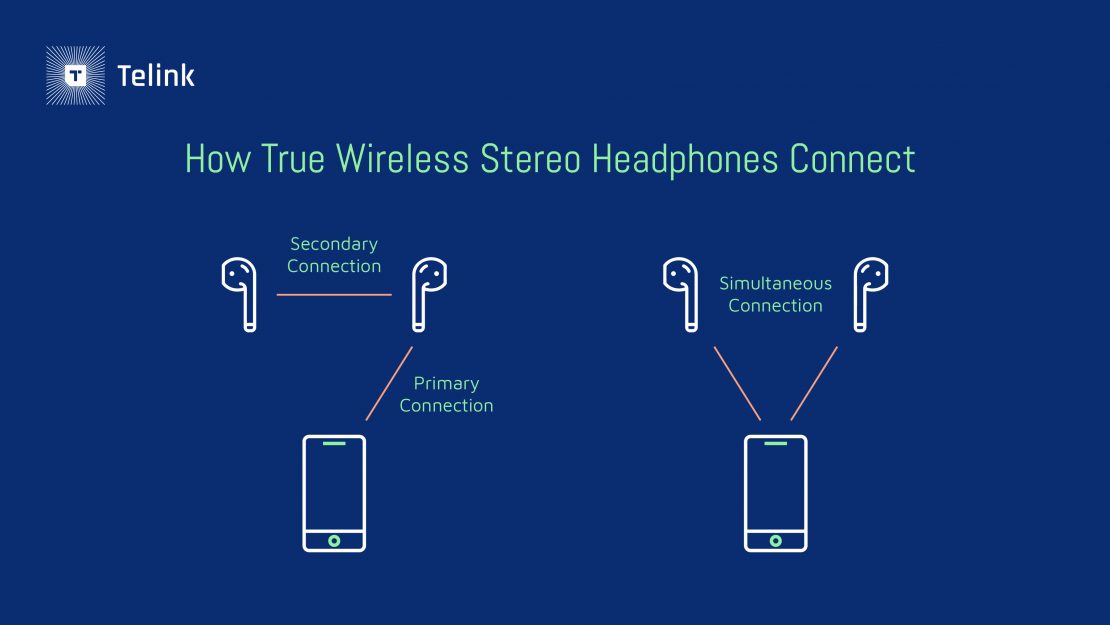



PLEASE ROTATE ME


Telink Staff
August 19, 2020
Applications

Find out more about True Wireless Stereo (TWS), the latest trend in Bluetooth® audio technology.
Popular consumer technologies today seem to share a common aesthetic — less is more. Apple’s latest releases, to consumers’ delight, have included thinner laptops without USB ports, seamless phones without home buttons, and headphones without wires.
Apple Airpods and other wireless earbuds have experienced explosive growth since 2016, and now represent the fastest-growing product in the audio segment. According to market analysis by Canalys, wireless earbuds blew past wireless earphones and headphones in 2019, with an annual increase of about 183 percent. 43 million wireless earbuds shipped in the third quarter of 2019, making them the largest category in the smart personal device audio market.
Many popular Bluetooth® accessories like earbuds are advertised as “True Wireless,” but what does that really mean? What is the technology behind it? To answer these questions and more, here is everything you need to know about True Wireless Stereo (TWS), the latest trend in advanced Bluetooth technology.
True Wireless Stereo (TWS) uses Bluetooth signals instead of wires or cables to transfer sound. TWS differs from wireless accessories that do not physically connect to a media source but still rely on physical connections to ensure that multiple parts of a device can function together. Wireless sport headphones that are joined by a wire that wraps around the user’s neck are an excellent example of this.
Accessories using true wireless technology, on the other hand, are just that — truly wireless. They do not need wires to connect to a media source device or link one earbud or speaker with the other. Bluetooth chips establish a completely wireless connection.
Depending on the brand and the accessory in question, different TWS devices connect to media sources in different ways. Many TWS headphones use a single earbud as the primary connection between the media source and the second earbud. Earbud one sends a signal to the source device, connects, and then the source device forwards the same signal on to earbud two, providing an immersive surround-sound experience.

Others — such as Qualcomm’s TrueWireless Stereo Plus — establish a connection between the earbuds first so the media source device can connect to them both. From there, the accessory’s Bluetooth chip sends audio simultaneously to earbuds one and two. This prevents undue strain on only one earbud, improves connection strength, and provides clearer audio.
True wireless technology offers many advantages, but primarily, it’s attractive because it’s convenient and easy-to-use. Cable-free functionality means users are free to move around without worrying about cables getting tangled in pockets or snagging on door handles. Most TWS devices have a Bluetooth range upwards of 30 feet while still keeping a clear connection — making them ideal for yard work or exercise. TWS earbuds are also remarkably easy to pair, easy to use, and have a 75 percent longer battery life than traditional wireless earphones.
True wireless technology also offers high-quality stereo sound and an immersive audio experience. TWS delivers the left and right audio channels to the connected device separately by assigning the left channel to the left earbud and the right channel to the right earbud. When users have both earbuds in they’ll have clear, crisp surround sound. Even if users wear just one earbud, they will still have a complete audio experience — the audio isn’t split, so it doesn’t sound like instruments and vocals are delivered to separate earbuds.
While earbuds are currently the most popular product to make use of true wireless technology, TWS is not limited to just earphones. TWS is also the latest innovation in Bluetooth speaker technology. TWS stereos connect to the main speaker using a smartphone or laptop, and then the main speaker connects to the secondary speaker via Bluetooth signals.
If a user wanted to play music throughout their home during a party, for instance, they could place one TWS speaker in the living room and another in the dining room — projecting the music across an entire floor. The portable batteries can last up to 15 hours and produce surround-sound quality audio without a home theater system. Also, most true wireless stereo systems come with Bluetooth-enabled remote controls that allow users to fast forward, skip tracks, and adjust the volume from a distance.
True wireless technology has also been applied to chargers. Wireless charging company Energous has been developing true wireless charging technology, called WattUp, that would allow users to charge their devices simply by placing them within 15 feet of the charging pad. WattUp received certification from the Federal Communications Commission in 2018, and true wireless charging could be ready very soon.
As the benefits of True Wireless Stereo become clear — convenience, audio quality, and easy setup — the market for Bluetooth TWS products like wireless earbuds will continue to grow. For device developers, the time is ripe for innovation.
Whether you are looking to improve upon TWS headphones or develop new uses for true wireless technology, Telink chips make a difference where it counts. Our Bluetooth chips are power-efficient, cost-efficient, and extend the battery life of the devices they power. When applied to audio equipment, our tried-and-tested Bluetooth stack produces superior audio quality at scale.
The TLSR9518 Series is a RISC-V-based multiprotocol chip for the next generation of TWS audio systems, and is the latest addition to Telink’s line of complete connectivity solutions that are designed to maximize device performance. Telink provides turn-key product design references and charging case references to support high-efficiency basic Bluetooth TWS solutions with embedded keyword wakeup, acoustic echo cancellation, and TWS mode for music streaming and voice calls. The TLSR9518 also delivers both electronic noise cancellation (ENC) and active noise cancellation (ANC) capabilities and supports ultra-low latency Bluetooth LE 5.2 TWS solutions that utilize either a connected isochronous stream (CIS) or broadcast isochronous stream (BIS) approach.
For more details on our chips and applications, contact us today.